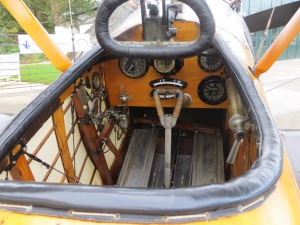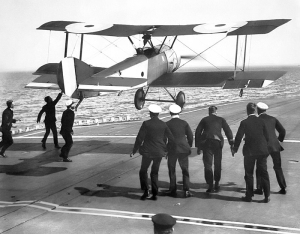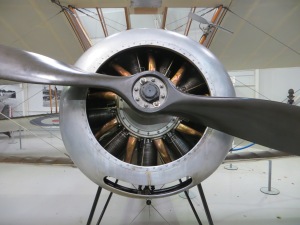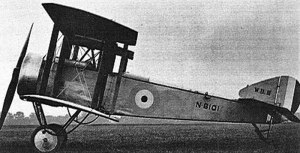“Good god, your 1 1/2 Strutter has had a pup!”
Those were the words of an RFC officer upon first seeing the new Sopwith Scout being testes in early 1916.
Though very similar in construction to the Tabloid, this new Scout aircraft was far lighter than its older relative, allowing it to have a lower powered engine and still have a higher performance. This increased performance soon became apparent, with a Top Speed of 111 mph, rather than the Tabloids 87, and a ceiling of 17,500 feet, again compared to the Tabloids modest 7000. Much like its then stablemate, the Strutter, the Scout had a forward firing vickers machine gun firing through the propellor. The aircraft was powered by a Le Rhone rotary engine.
The first prototype was rolled out with the number 3691 and was deemed ready to test on the 9th Feburary 1916, this was a telling time for new aircraft as the much feared “Fokker Scourge” was at its peak.
It was during this early testing process that the “Pup” comment was made, in fact it was made by several people, resulting in the aircraft soon became known by most as the Pup. It is easy to see why, it shares the half struts from the inner wing to the cockpit much like its bigger brother, but the Pup was so much more, with outstanding performance in the air.
First orders were placed for the type in April 1916, with the first aircraft reaching the front in September with the Royal Navy Air Service. The first victory was claimed on the 24th Feburary, in the orginial prototype 3691, piloted by Stanley Globe of “A” naval sqaudron. While the RNAS were well catered for with Pups at this stage, the RFC would not recieve any till Christmas eve, with the Battle Of the Somme still ongoing the flying corps had to beg the RNAS for some support at the front.
A new squadron was formed for this role – 8 Naval Squadron and was formed on the 26th October. This sqaudron performed well against the German aircraft of the time, slowly racking up kills into 1917. On the 4th January however three pilots; Grange, Robert Little and Allan Todd attacked a formation of seven Albatross D.IIs, Grange shot down three of the German aircraft, but Todd got caught by three aircraft and was shot down.
One of the three pilots was none other than Van Richtofen, the red baron, who landed his Albatros near where Todd had crashed and removed the aircrafts identity code to keep as a trophy.
Richtofen commented that the Pup was clearly superior to their aircraft and they only found success because they outnumbered the Sopwith 3 to one.
Most of the German air force shared Richtofen’s sentiment, so much so that whenever a serviceable Pup fell into German hands they were immediately pressed into service.
Royal Flying Corps:
As mentioned above no Pups were delivered to the RFC until Christmas Eve 1916, the first squadron to take delivery was 54.
Soon after delivery pilots were already praising the new little Sopwith, Robert Foster commented looking back that the Pup was certainly the finest flying aeroplane of the day.
Amazingly, considering how we see these aircraft flown now Pups were regularly flown up to 18,000 feet. This was part of the complex battle of gaining the height advantage over the enemy, allowing a surprise attack.

How little protection from the elements Pup pilots would have had up at 18,000ft is clearly shown here.
These high altitude patrols proved testing during the very cold winter of 1916/17 with many pilots getting frost bite as well as throttles freezing up, though in testament to the Pup design they rarely failed due to the cold.
The only complaint that was found at the time was how light the airframe was. Flying in strong winds was problematic enough in the Great War but with such a light frame the Pup was especially vulnerable.
Top Ace:
28 pilots achieved the status of ace whilst flying the Pup and the Highest scoring of those was Maurice Douglas Guest Scott.
Scott was born on the 13th November 1895 and served with the 3rd Loyal North Lancashires, but soon transferred to the RFC in February 1916.
His career with the RFC started as an observer in the Vickers FB.5 Gunbus aircraft, before later training as a pilot. He was first part of 54 Squadron, the first to receive the Pup, with whom he claimed four victories. He then moved to 46 Squadron, where he became a flight commander and went on to claim a further 7 kills.
He was awarded the Military cross in October 1917 and was posted to the home front that same month. Sadly Scott was killed in a flying accident at Shoreham on the 17th March 1917
Withdrawn From The Front:
As is often the irony with First World War aviation, no sooner has an aircraft been dubbed as the greatest of the time than it is outclassed. The Pup was no different and, by the summer of 1917 things weren’t looking good for the Sopwith, in fact all aircraft were withdrawn by the years end.
The war wasn’t over for the little scout however, as it was still incredibly manoeuvrable and potent at high altitude. The home defence role quickly came calling and two Pup squadrons took on the role. This relocation was brought about by a raid on London by Gotha G.IV bombers on the 25th May 1917.
Before taking on the German Air Forces bombers, the Pup got something of a make-over, with the addition of a 100hp Gnome engine as well as an additional Lewis gun placed above the wing.
Carrier “Pups”
For much of the war the Navy had gotten by with using floatplanes or flying boats as their sea-bound defence option, often being launched from ships, landing nearby and being recovered on deck.
However most of those designs flying at the time were very fragile machines and not really fit for purpose. This problem brought about the suggestion of flying a wheeled Sopwith Pup from the deck of a ship, much like the Hurri-cats of world war two, landing wasn’t really on the agenda of those in charge at the time.
If the pilot wasn’t able to reach land before running out of fuel then they would simply ditch, as it was believed this would even be safer than landing the fragile floatplanes and flying boats on the water.
Early trials of this new way of operating didn’t really go according to plan, it was found that once ditched, assuming it was successful, the Pup would sink in as little as 20 minutes due to the size of the engine. All well and good if you happen to ditch along side a ship, but a worry if not. Another problem that came about was that the aircraft tended to flip over onto the back as soon as they made contact with the water.
Following these setbacks trials were carried out to install airbags in the tails of Pups which would inflate, adding buoyancy to the aircraft overall, which did lead to the aircraft staying afloat much longer (in the region of 6 hours) but the nosing over was still an issue.
The decision was taken that the issue was clearly caused by the landing gear, so a system where the undercarrige could be released was installed, but this did little to solve the problem in reality. Hydrovanes were eventually installed in the airframes and this seemed to solve the problem.
On the 28th June 1917, Frederick Rutland, a Naval officer who was a strong campiagner for the use of Pups on ships, took off from a 19ft platform placed over the gun of the HMS Yarmouth light cruiser. In order to take off in such a short distance the ship had to be going at top speed. The trial proved successful and it was decided that each cruiser squadron would have one ship with the modification made.
Building from this success Edwin Dunnnig took off from the deck of aircraft carrier HMS Furios on the 2nd of August. Nothing new so far, but what made this flight impressive and important is that Dunning was then able to land on the deck again! This process was repeated on the 7th August, but sadly did not go to plan, the Pup ended up going off the side of the deck and Dunning was killed.

Dunning attempting a landing on HMS Furious on the 7th August. The crew can be seen trying to pull the aircraft down. Sadly this attempt was unsuccessful and Dunning was killed.
The first combat mission flown from the deck of a ship came on the 21st of August when Bernard Smart flew a Pup off of the Yarmouth Crusier to attack a Zeppelin. Diving down on the airship from 7000ft Smart opened fire. As he pulled away from the attack he ntoed the Zeppelin was smoking and heading towards the sea. Smart had by this point flown too far and could not make it to land, so he ditched in the sea. He was later picked up though his aircraft sank.
Rocket Assisted
Those readers who have visited the Shuttleworth Collection at all will have seen their Pup carries a series of rockets on the outboard strut of each wing. These were known as Le Prieur rockets and were designed to bring down Zeppelins. The rockets were fitted to both Shipboard and Home defence aircraft.
The Rockets were ignited electronically by the pilot, the signal sent would launch all of the Rockets at once. The ideal point of release was between 350 and 500 feet away while in a dive of at least 45 degrees. While this weapon and method did prove effective against observation balloons it was never successful in its main task of downing Zeppelins.
Folding Pups
William Beardmore and Co were responsible for building a high number of the Pup aircraft, as Sopwith were busy with the Strutter design. As the Pup was such a popular design with the Navy and on ships it was decided that some more major modifications should be made.
The most drastic change came in the wings, the forward stagger of the top wing was removed so both wings sat directly in line with each other, this meant they could then be folded back.
Along with the wing fold the undercarriage was also designed to fold up into the fuselage. The company also added more sophisticated floatation gear and lengthened the fuselage, 100 of these aircraft were build. This variation on the Sopwith design became known as the Beardmore W.B.III.
Although the Beardmore was the last obvious development on the Pup there was one other aircraft to come from the basic design, the Sopwith Triplane. Which will be the subject of the next Warbird Tails Sopwith Profile.
Survivors
Only three original Pups survive around the world, N5182, built in 1916 is currently on display at RAF Cosford, N5195 is on display at the Museum of Army Flying and saw service in France during the war and B1807, the last static machine, was built in 1917 specifically for the home defence roll, it is now in storage at the Fleet Air Arm Museum at Yeovilton.
One other Pup is on display in the UK and is the main photographic subject of this post, though originally built as a Dove the aircraft was converted to Pup standard during the 1930s, as such it has spent much more of its life as a Pup than a Dove! As can be seen from these photos the Pup is kept in superb condition. It still flies at numerous airshows each year.
Another Sopwith Sucess
The Pup proved to be a very effective aeroplane in a time when the pendulum was just swinging back to Britain’s favour, it was able to build on the work the Strutters and Dh2s had been doing in regaining air superiority. While it only had a short front line life the advances it allowed in naval and home front operations would make a lasting impression of the future of air combat.
Don’t forget to hit follow below to get new posts directly to your inbox. Also check out Warbird Tails on Twitter and Facebook for extra content. Thanks for reading.









Hi,
On a Sopwith pup propeller are the stamps Short Nose, do you have any idea why this is on there? There doesn’t appear to be a long nose one.
LikeLike
Hi John, I must admit I am not sure…I could imagine it may to do with a propellor having the Hucks starter attachment or not, I’m certainly not aware of a long nose pup. I shall try and research this matter!
LikeLike
Thanks, an interesting one I think.
I got the question off the forum “woodenpropeller.com” which you might find interesting.
I have an early prop and other related items.
LikeLike